If print results are faint or streaks are present, the print head nozzles may be clogged. You may be able to improve print quality when you clean or deep clean the print head.
 Use only the approved methods described below to clean the print head. Other methods may further clog the nozzles and cause permanent damage to the print head.
Use only the approved methods described below to clean the print head. Other methods may further clog the nozzles and cause permanent damage to the print head.
Print a nozzle check pattern
-
Confirm that the printer is connected to the computer and the printer is turned on.
-
Complete or cancel any print jobs in progress.
-
Open the Printers folder.
-
Right-click the printer icon and select Properties.
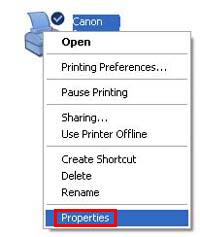
-
Select the Maintenance tab. The Maintenance window opens.
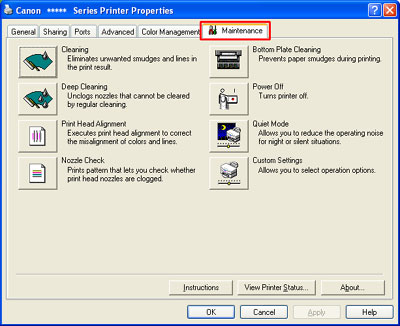
 The layout varies based on the printer and version of Windows.
The layout varies based on the printer and version of Windows.
-
Insert a piece of letter-sized plain paper in the cassette.
-
Select Nozzle Check.
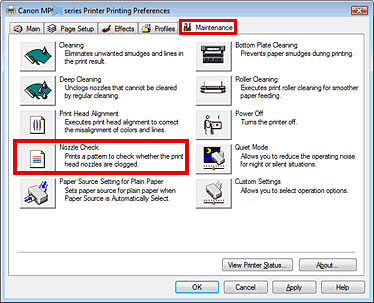
 If you select Initial Check Items before you select Print Check Pattern, you can see the specific confirmation items in Nozzle Check.
If you select Initial Check Items before you select Print Check Pattern, you can see the specific confirmation items in Nozzle Check.
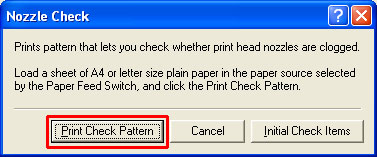
-
When the confirmation message is displayed, select OK. Nozzle check printing will start.
-
Examine the nozzle check output.
-
Determine whether the pattern is normal or not normal.
-
If the pattern is not normal, perform a cleaning.
 Perform this step first to clean the print head.
Perform this step first to clean the print head.
-
If the pattern is not normal after two cleanings, perform up to two deep cleanings of the print head.
 Cleaning consumes a certain amount of ink. Perform cleanings only when necessary.
Cleaning consumes a certain amount of ink. Perform cleanings only when necessary.
When the output is normal
-
If the print head performs as normal, cleaning is not required. Select Exit to return to the Maintenance window.
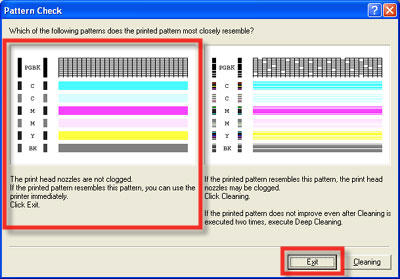
-
Select OK to finish and exit the Properties window.

Perform a print head cleaning
 Cleaning consumes a certain amount of ink. Perform cleaning only when necessary.
Cleaning consumes a certain amount of ink. Perform cleaning only when necessary.
 The pattern varies based on the printer and version of Windows.
The pattern varies based on the printer and version of Windows.
-
Select Cleaning to perform print head cleaning from the Pattern Check window.

-
To perform a print head cleaning from the Maintenance window, select Cleaning.
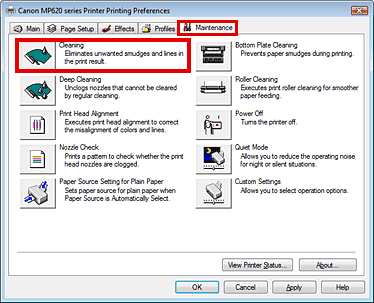
- When the print head cleaning window is displayed, select the target ink group for cleaning.
-
When you perform cleaning for All Colors, check All Colors.
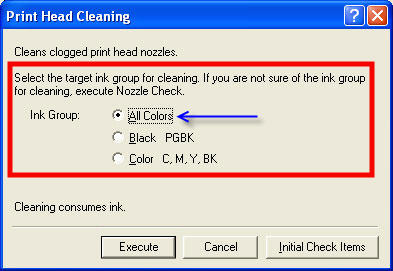
-
When you perform cleaning for Black only, deselect All Colors and check Black.
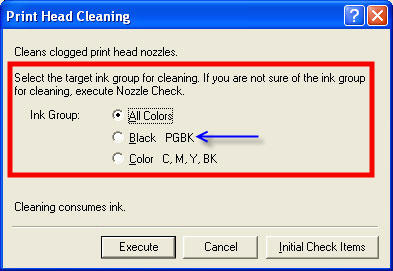
-
When you perform cleaning for Color only, deselect All Colors, and check Color.
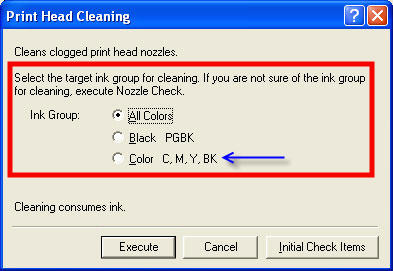
-
After you select the target ink group select Execute to perform the cleaning of the print head nozzles.
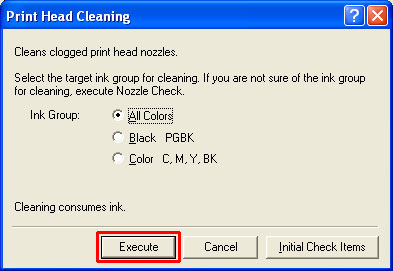
-
When the confirmation message is displayed, check the contents, and select OK.
 Although the nozzle check window is displayed, do not perform any other operations until cleaning is completed.. Cleaning will take about 40 seconds.
Although the nozzle check window is displayed, do not perform any other operations until cleaning is completed.. Cleaning will take about 40 seconds.
-
Print a nozzle check pattern and examine the result.
-
Perform cleaning again if necessary.
-
If the pattern is still abnormal after two cleanings, perform up to two deep cleanings.
Deep cleaning of the print head
 Deep cleaning consumes a larger amount of ink than normal cleaning. Perform deep cleanings only when necessary.
Deep cleaning consumes a larger amount of ink than normal cleaning. Perform deep cleanings only when necessary.
-
In the Maintenance window, select Deep Cleaning.

 The layout varies based on the printer and version of Windows.
The layout varies based on the printer and version of Windows.
- When the Deep Cleaning window is displayed, select the target ink group for Deep Cleaning.
-
When you perform cleaning for All Colors, check All Colors.
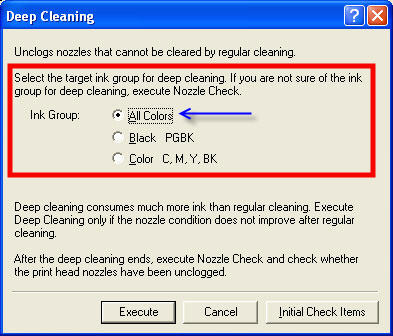
-
When you perform cleaning for Black only, deselect All Colors and check Black.
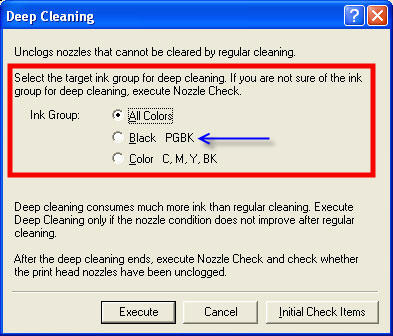
-
When you perform cleaning for Color only, deselect All Colors, and check Color.

-
Select Execute.

 If you select Initial Check Items before you select Print Check Pattern, you can see the specific confirmation items in nozzle check.
If you select Initial Check Items before you select Print Check Pattern, you can see the specific confirmation items in nozzle check.
-
When the confirmation message is displayed, select OK. The power lamp will blink green and deep cleaning starts. The blinks stops when deep cleaning is over.
-
When deep cleaning starts, check the contents, and select OK.
 To prevent interruption of the deep cleaning process, do not perform any other operations until deep cleaning is completed. When the operation of the printer is stopped, deep cleaning is completed. Deep cleaning will take about 75 seconds.
To prevent interruption of the deep cleaning process, do not perform any other operations until deep cleaning is completed. When the operation of the printer is stopped, deep cleaning is completed. Deep cleaning will take about 75 seconds.
-
Print the nozzle check pattern again.
 If the printed pattern is still not normal, perform steps 1 through 4 of the deep cleaning process one additional time.
If the printed pattern is still not normal, perform steps 1 through 4 of the deep cleaning process one additional time.
 If after two deep cleanings and the nozzle check pattern is still not normal, turn the printer off and let it sit for 24 hours or more before you begin another deep cleaning again. The wait time may allow dried ink in clogged print head nozzles to liquefy, and resolve the problem.
If after two deep cleanings and the nozzle check pattern is still not normal, turn the printer off and let it sit for 24 hours or more before you begin another deep cleaning again. The wait time may allow dried ink in clogged print head nozzles to liquefy, and resolve the problem.
When the output is normal
When the output is not normal
-
Case A: No color is printed.
-
Case B: There is any color that is not printed at all. (In the sample below, black ink is not printed at all.)
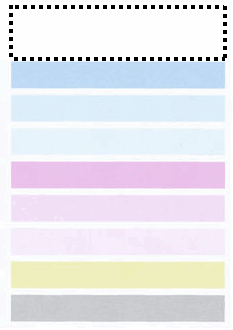
-
Case C: There are missing lines partially in the pattern for the black ink.

-
Case D: There are white streaks in one of the color ink patterns.

Printers folder
For Windows XP Home Edition
For Windows XP Professional Edition
For Windows 7
For Windows 2000
For Windows Vista
If your product issue was not resolved after following the steps above, or if you require additional help, please create or log in to your Canon Account to see your technical support options.
Or if you still need help, visit our Canon Community by clicking the button below to get answers:

____________________________________________________________________________________________